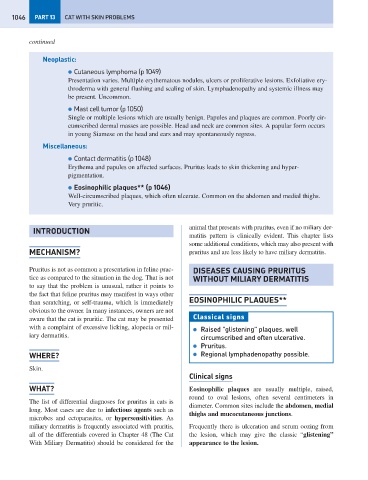Page 1054 - Problem-Based Feline Medicine
P. 1054
1046 PART 13 CAT WITH SKIN PROBLEMS
continued
Neoplastic:
● Cutaneous lymphoma (p 1049)
Presentation varies. Multiple erythematous nodules, ulcers or proliferative lesions. Exfoliative ery-
throderma with general flushing and scaling of skin. Lymphadenopathy and systemic illness may
be present. Uncommon.
● Mast cell tumor (p 1050)
Single or multiple lesions which are usually benign. Papules and plaques are common. Poorly cir-
cumscribed dermal masses are possible. Head and neck are common sites. A papular form occurs
in young Siamese on the head and ears and may spontaneously regress.
Miscellaneous:
● Contact dermatitis (p 1048)
Erythema and papules on affected surfaces. Pruritus leads to skin thickening and hyper-
pigmentation.
● Eosinophilic plaques** (p 1046)
Well-circumscribed plaques, which often ulcerate. Common on the abdomen and medial thighs.
Very pruritic.
animal that presents with pruritus, even if no miliary der-
INTRODUCTION
matitis pattern is clinically evident. This chapter lists
some additional conditions, which may also present with
MECHANISM? pruritus and are less likely to have miliary dermatitis.
Pruritus is not as common a presentation in feline prac- DISEASES CAUSING PRURITUS
tice as compared to the situation in the dog. That is not WITHOUT MILIARY DERMATITIS
to say that the problem is unusual, rather it points to
the fact that feline pruritus may manifest in ways other
than scratching, or self-trauma, which is immediately EOSINOPHILIC PLAQUES**
obvious to the owner. In many instances, owners are not
aware that the cat is pruritic. The cat may be presented Classical signs
with a complaint of excessive licking, alopecia or mil- ● Raised “glistening” plaques, well
iary dermatitis. circumscribed and often ulcerative.
● Pruritus.
WHERE? ● Regional lymphadenopathy possible.
Skin.
Clinical signs
WHAT? Eosinophilic plaques are usually multiple, raised,
round to oval lesions, often several centimeters in
The list of differential diagnoses for pruritus in cats is
diameter. Common sites include the abdomen, medial
long. Most cases are due to infectious agents such as
thighs and mucocutaneous junctions.
microbes and ectoparasites, or hypersensitivities. As
miliary dermatitis is frequently associated with pruritis, Frequently there is ulceration and serum oozing from
all of the differentials covered in Chapter 48 (The Cat the lesion, which may give the classic “glistening”
With Miliary Dermatitis) should be considered for the appearance to the lesion.

